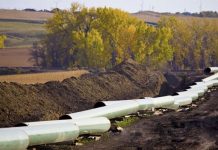
June 1 (UPI) — Oil is now flowing through the controversial Dakota Access pipeline, carrying crude from Canada and North Dakota south to Illinois, its developer said Thursday.
The pipeline, which sparked a months-long protest by Native Americans and environmental groups, is 1,172 miles long. It carries oil pumped out of the Bakken oil formation in Canada and parts of the northern U.S. plains south to a major pipeline hub, where it can be sent to Gulf Coast refineries.
The Sioux nation first protested the pipeline during the Obama administration, arguing it ran close to the Standing Rock Sioux reservation and over land they consider historically sacred. Calling themselves the water keepers, protesters noted the potential danger to the Missouri River and its tributaries should the pipeline rupture.
The crowd of protesters camped near the construction site grew into the thousands and occasionally sparked violent encounters with local police and private security for the pipeline’s developer, Energy Transfer Partners.
Protesters won a short-lived reprieve in the waning days of the Obama administration, when the Army Corps of Engineers, at the former president’s order, issued a finding that would have required the developer to pay for a years-long environmental impact study of the pipeline’s potential danger to Lake Oahe, the Sioux nation’s primary source of drinking water.
The pipe passes under the lake.
When operating at full capacity, the Dakota Access pipeline is capable of carrying 570,000 barrels of oil per day. It cost $3.8 billion to build.
Although it is now operational, the court battle continues, with protesters arguing the government did not follow its own ruling when President Donald Trump took office and nixed the lengthy environmental review, clearing the way for final construction.
In March, a federal judge in Washington, D.C., denied a request by the Sioux nation to order an emergency injunction preventing the pipeline from becoming operational.





